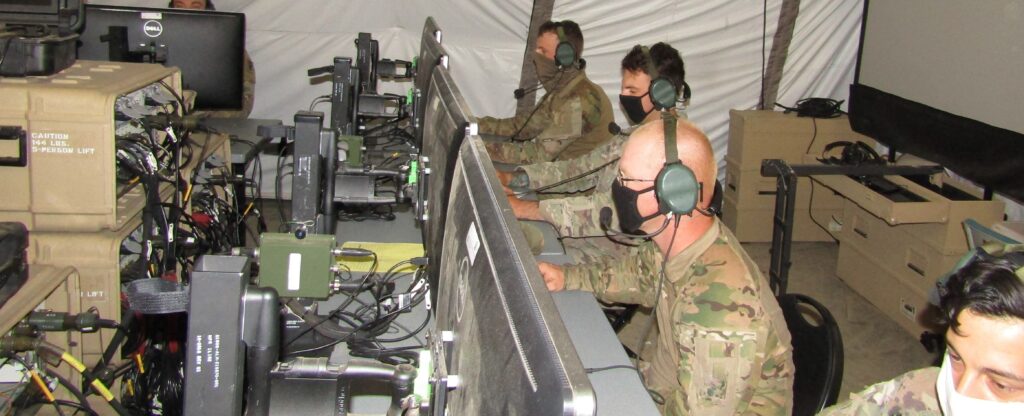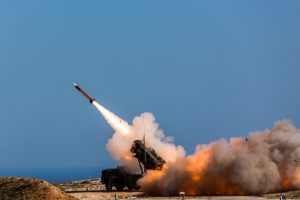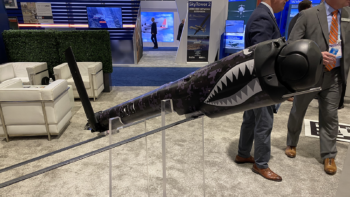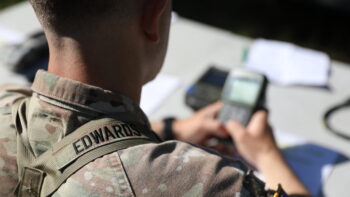
Soldiers operate an IBCS command post during the Limited User Test.
WASHINGTON: The Army’s new missile defense network just passed its second live-fire flight test in two weeks. Once again, IBCS coordinated the near-simultaneous shootdown of two target drones.
But “it is so much more than shooting at two missiles,” said Gen. Joseph Martin, the Army Vice-Chief of Staff, who visited White Sands Missile Range with Under Secretary James McPherson to observe Thursday morning’s test.

Patriot missile launch
While last week both targets were the same type, MQM-178 Firejet drones, flying in close formation, this week there were two very different targets on radically different trajectories: an MQM, flying low and (relatively) slow like a cruise missile, and a Black Dagger/Boosted Zombie, flying high and fast like a ballistic missile. A single Patriot missile defense radar can’t watch both high and low at once – but the whole point of IBCS is to connect previously incompatible systems, in this case Patriot and Sentinel, and let any command post on the network get high-fidelity data from different kinds of radars in different locations.
In one aspect, though, this week’s test was actually less challenging than last week’s. This time there was no enemy jamming disrupting the IBCS network’s transmissions, as there was last time and as there would be in a war with Russia or China. Overall, said Maj. Gen. Robert Rasch, the Army’s Program Executive Officer for Missiles & Space, the complexity of the two live-fire tests was “about the same.”
If you really want to replicate a Russian or Chinese-style barrage, however, you need to launch hundreds of incoming enemy missiles of multiple types – something you can only safely and affordably do in simulation. So, Army brass told reporters Thursday afternoon, that’s exactly what they did, over and over, as part of the first IBCS battalion’s ongoing Limited User Test.
“The most stress these soldiers and this system see is actually done in simulation, where they’re faced with literally hundreds of threats they have to discriminate and defeat in a very short period of time,” said Col. Phil Rottenborn, the Army’s project manager for IBCS. “And these soldiers went through three weeks of those stressing targets. I think if you ask them, that might even be more stressful than these live fires.”
“What really we’re after for them is a stressing environment which we can only do in simulation, because obviously we want to fly a lot of targets [and] different kinds of targets all at the same time,” said Col. Tony Behrens, the Army Capability Manager for air & missile defense. “They’ve been able to demonstrate they can handle that with this system.”
“We demonstrated that in this test more than once per crew,” added Brig. Gen. Brian Gibson, the modernization director for air & missile defense at Army Futures Command. “In fact, we did it at varying levels for each crew, multiple times, day or night.”
“So I’m very confident, Syd, that we have stressed the system and the soldier to the point, with sufficient complexity, to best understand how they operate and how the system operates,” Gibson said.
But if the live-fire tests aren’t to stress the system, what are they for? Their main purpose is to get real-world data to confirm – or correct – the Army’s simulations, particularly the ultra-detailed physics models used to calculate optimal interceptions. Those are “very high-fidelity sims,” Rasch explained, “that do “hundreds of thousands of runs” testing a vast range of different variables, using what’s called a Monte Carlo approach (first employed in the Manhattan Project). There’s no way to run that many tests in the real world, but if your real-world data matches the model, it gives you more confidence that your high-speed computations are correct.
While the live-fire portion of this fall’s Limited User Test is now over, there are more ahead. The program will conduct a developmental flight test in July 2021, designated Flight Test 6. Then the Pentagon’s independent testing arm will run a massive Initial Operational Test & Evaluation (IOT&E) that starts around September ’21 and runs well into 2022.
“As we finish this assessment, this LUT, which completes around the middle of September, the battalion only gets a couple of weeks [off],” said Col. Behrens. Then it’s back to training on IBCS – including any modifications made based on feedback from the LUT – and refining the Tactics, Techniques, & Procedures (TTPs) to use it in combat.
As a result, “when we get to IOT&E, the goal is they’re operating at a much higher capability than what they are today,” Behrens said.
“We do expect the level of complexity of the testing to increase in IOT&E,” added Col. Rottenborn.
This latest test “is not a capstone event,” Gen. Martin emphasized. “It is one of many milestones en route to delivering appropriate capability to our soldiers.”
Lockheed, Howmet settle lawsuit over F-35 titanium (EXCLUSIVE)
Lockheed Martin alleged in court filings that Howmet cut off the supply of titanium after the aerospace giant refused to agree to higher prices, threatening production of the F-35.


























